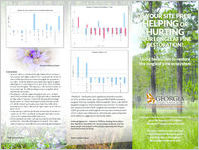IS YOUR SITE PREP
HELPING OR HURTING
YOUR LONGLEAF PINE
RESTORATION?
Eastern Silvery Aster
Conclusions Several widely available herbicides (metsulfurin, triclopyr, hexazinone and higher rates of ULW appeared to conserve much of the groundcover and encouraged key grasses on our sites. Some treatments had moderately good longleaf seedling survival during our two-year trial, which included two severe droughts. During years with normal rainfall we have observed 70-80% planting success using the aforementioned herbicides. Treatments with the highest longleaf pine survival (tank mixes that included imazapyr and glyphosate or moderate to high rates of imazapyr alone) did the greatest damage to groundcover. These treatments diminished the quality of wildlife habitat and made prescribed fires difficult to execute on our study sites due to high weedy cover and low grass cover. Some imazapyr plots experienced substantial increases in woody cover. This was due to increased blackberry cover, which in turn made plots difficult to burn. These methods are likely not appropriate for old-field sites, particularly where Bermudagrass is present. Only high rates of imazapyr are effective at controlling Bermudagrass.
Stiff-leaved Aster
*Methods herbicides were applied by boomless nozzles on ATVs at three study sites (Sprewell Bluff WMA/montane longleaf; Fall Line Sandhills WMA/sandhills; Silver Lake WMA/ longleaf wiregrass). Each treatment was 66'x66'. Groundcover was measured in fall 2009, longleaf were planted in winter 2009, groundcover and longleaf survival were remeasured in 2012. Labels were followed on all herbicides and surfactants were added as suggested on herbicide labels.
Acknowledgements thanks to TERN for funding this publication, Red River Specialties Inc. for providing chemicals, and the many people who helped on this project, especially Hal Massie, Tom Patrick and Lisa Kruse.
Yellow Indian Grass
Using herbicides to restore the longleaf pine ecosystem
Georgia Department of Natural Resources Wildlife Resources Division
Nongame Conservation Section For more information contact: nathan.klaus@dnr.state.ga.us
alan.isler@dnr.state.ga.us jklaus@gorsdonstate.edu
Successful planting of longleaf pine should not be mistaken for successful restoration of the longleaf pine ecosystem. Longleaf pine groundcover makes up much of the botanical diversity of longleaf pine systems and is what drives most wildlife populations. It is also a critical fuel input for the successful use of prescribed fire and is key to the long-term stability of the forest. Your choice of herbicde will not only impact planting success but will impact groundcover for decades to come and ultimately the success or failure of your restoration project.
During the course of fifteen years of longleaf pine restoration we observed many good and bad effects of herbicides on groundcover. In 2009 we began field trials to investigate herbicide effects using combinations and rates of herbicide we frequently used during longleaf pine restoration (*see back for study methods). The intent was to evaluate our methods across the range of longleaf ecosystems in Georgia (montane longleaf, sandhills, and longleaf wiregrass) to improve state restoration efforts and to share these results with other land managers.
WHAT IS GROUNDCOVER?
Groundcover are the low growing plants, mostly herbaceous, that are associated with frequently burned healthy longleaf pine forests. In a healthy longleaf pine forest it should include hundreds of species, from sunflowers to blazing star, partridge pea to runner oak.
Carolina Pinelandcress
Good site prep should: assist with the successful establishment of longleaf pine conserve key grasses such as wiregrass, little bluestem and Indian grass. control hardwood competition that competes with longleaf seedlings allow prescribed fire to be successfully used soon after planting and throughout the life of the stand maintain a wide variety of herbaceous plants such as legumes, composites and grasses to provide food and cover for wildlife limit the introduction or encouragement of weeds
We observed substantial differences in herbicide effectiveness and longleaf planting success between sites. Your experience with these techniques will likely differ from ours from site to site and year to year. This publication does not intend to recommend any particular site prep chemical or rate but only to share our results and encourage consideration of alternatives.
Eastern Green Eyes
Sandhill Scrub Mint
Longleaf survival (2 years) and change in longleaf groundcover
0.9
0.9
Bad site prep may: prevent the successful use of prescribed fire, causing hardwood sprouts to recapture the site and compete with longleaf seedlings encourage weeds such as dogfennel, climbing fern, rattlebox and blackberry that compete with longleaf and deteriorate wildlife habitat eliminate much of the botanical diversity that makes longleaf pine forests the beautiful places we all enjoy
0.7 0.5
Lopsided Indian Grass 0.3
0.7
Purple Foxglove
0.5
0.3
% longleaf pine survival imazapyr 48oz/ac
control imazapyr 40oz/ac+glyphosate 64oz/ac
imazapyr 40oz/ac+triclopyr 64oz/ac ULW 3lbs/ac
metsulfurin 2oz/ac imazapyr 32oz/ac+metsulfurin 1oz/ac
imazapyr 32oz hexazanone grid 96oz/ac
triclopyr 128oz/ac imazapyr 32oz/ac+glyphosate 128oz/ac
ULW 6lbs/ac % longleaf groundcover -- devia1on from control
0.1
0.1
--0.1
--0.1
Large-flowered Partridge Pea
--0.3
--0.3
--0.5
--0.5
--0.7
--0.7
--0.9
--0.9
longleaf survival (2 years) longleaf groundcover survival
Yellow Pitcher Plant
